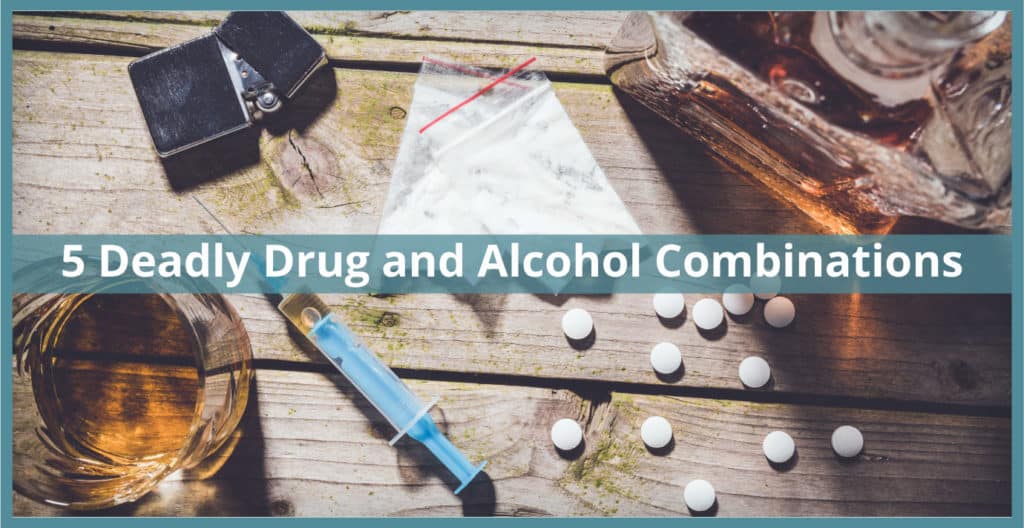Overdose can sneak up on people who combine substances, which is referred to as polydrug use. They may think they understand their tolerance of the drugs in question. One or more of the drugs may be legal or was even prescribed by a doctor. For the sake of your health and the health of your loved ones, educate yourself on the hazards of polydrug use. Here are five alcohol combinations that pose a deadly risk:
1. Alcohol And Opioids
Synthetic opioids like oxycodone, hydrocodone, and tramadol are all frequently prescribed as painkillers. In addition to relieving pain, opioids induce a sense of wellbeing and euphoria while simultaneously slowing or shutting down organ functions. When you take alcohol and opioids together, it accelerates the slow down of organ functioning, producing an intense euphoria or numbness. This is dangerous and can result in:
- Dangerously depressed breathing, leading to respiratory arrest.
- Dangerously reduced heart rate and blood pressure, leading to cardiac arrest.
- Severely impaired muscle coordination, increasing the risk of injury.
- Loss of consciousness, leading to coma.
2. Alcohol And Benzodiazepines
Sometimes shortened to the nickname “benzos,” benzodiazepines have become household names, frequently prescribed by doctors to treat the modern epidemic of anxiety disorders. You have probably heard the brand names of the most common benzos:
- Xanax
- Klonopin
- Librium
- Valium
- Ativan
Less well-known is the fact that benzodiazepines are highly addictive. They boost the activity of GABA, an inhibitory neurotransmitter associated with an increase in dopamine, the same “reward” hormone associated with an opioid “high.” All the dangers incumbent in mixing alcohol dependence with heroin or oxycodone applies to benzos like Xanax or Klonopin. Worst of all, alcohol is legal, benzos are widely prescribed, and both have become socially acceptable.
3. Alcohol And Barbiturates (Or Any Depressant)
In addition to alcohol and benzos, barbiturates are another class of depressant worth mentioning. Benzos have largely supplanted them on prescription pads, but you might still encounter them in the form of trade names like:
- Seconal
- Butisol
- Luminal
- Pentothal
- Tuinal
Any combination of two or more depressants puts your body in danger, with potentially deadly results.
4. Alcohol And Cocaine
Contrary to the previous examples, cocaine is a stimulant, the opposite of a depressant. Common side effects include agitation, panic, paranoia, and restlessness. Both cocaine and alcohol are also widely accepted as party drugs, increasing the likelihood of this polydrug combination. This acceptance is extremely misguided. When they meet in the liver, the two chemicals synthesize an entirely different chemical—cocaethylene. Cocaethylene is a cardio-toxin. An excess of this chemical can lead to sudden cardiac arrest. Alcohol and cocaine also tend to counteract each others’ effects. Cocaine stimulates the production of norepinephrine, an alertness hormone that staves off the dullness of alcohol. The alcohol, meanwhile, takes the edge off of cocaine agitation.
5. Alcohol And MDMA
Another party drug often mixed with alcohol, MDMA may go by the names Molly, Mandy, or Ecstasy. A stimulant, MDMA causes a rush of euphoria, as well as heightened empathy and reduced inhibitions. Highly addictive, it also leads to dehydration, hyperthermia, increased blood pressure, erratic behavior, and other unpleasant side effects. When alcohol and MDMA are mixed, it can lead to dangerous levels of dehydration. It is entirely possible to die of thirst in one night from this deadly combo. Sources: George Mason University—Barbituates National Institute on Alcohol Abuse and Alcoholism—Harmful Interactions: Mixing Alcohol With Medicines Vice—This Is What Happens When You Combine Molly and Alcohol








